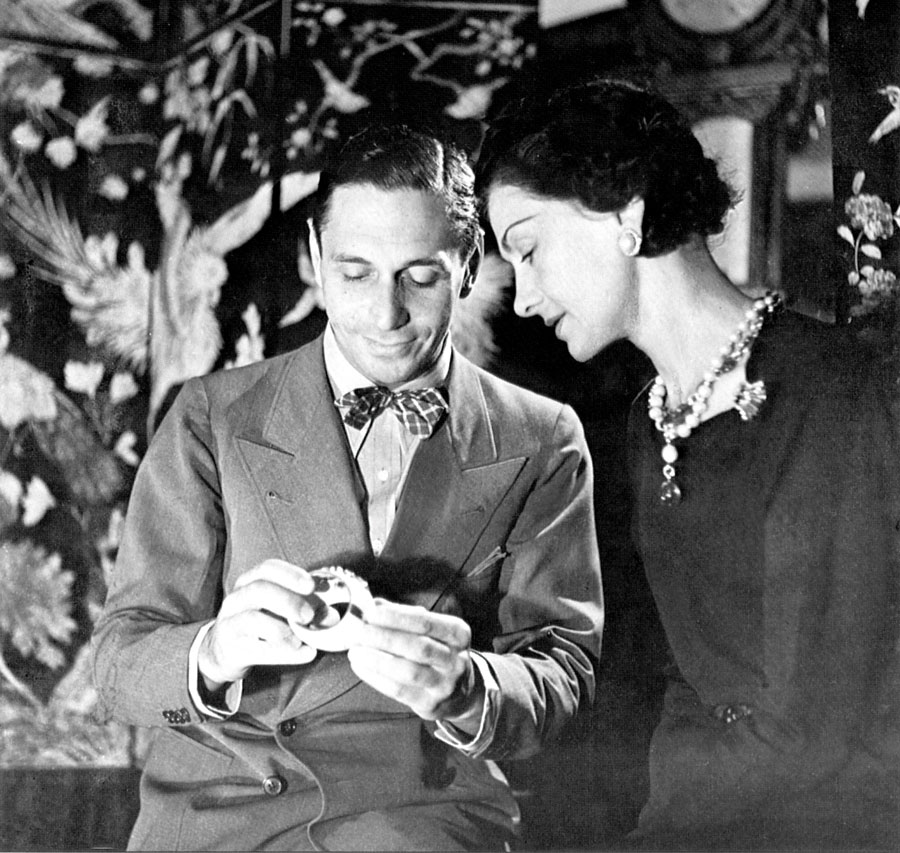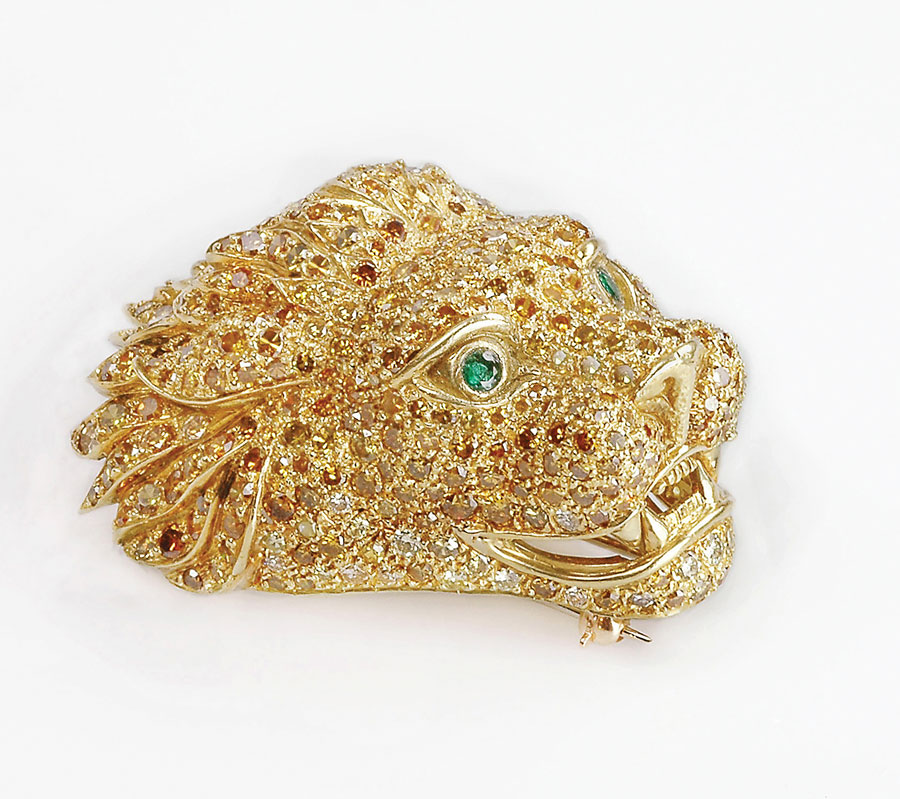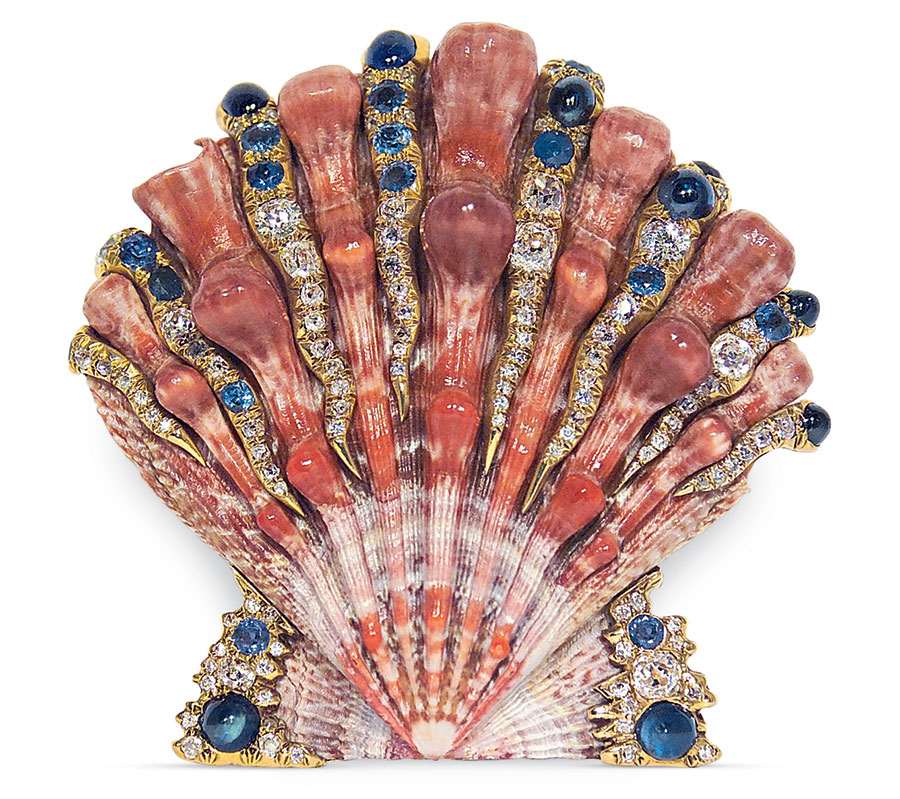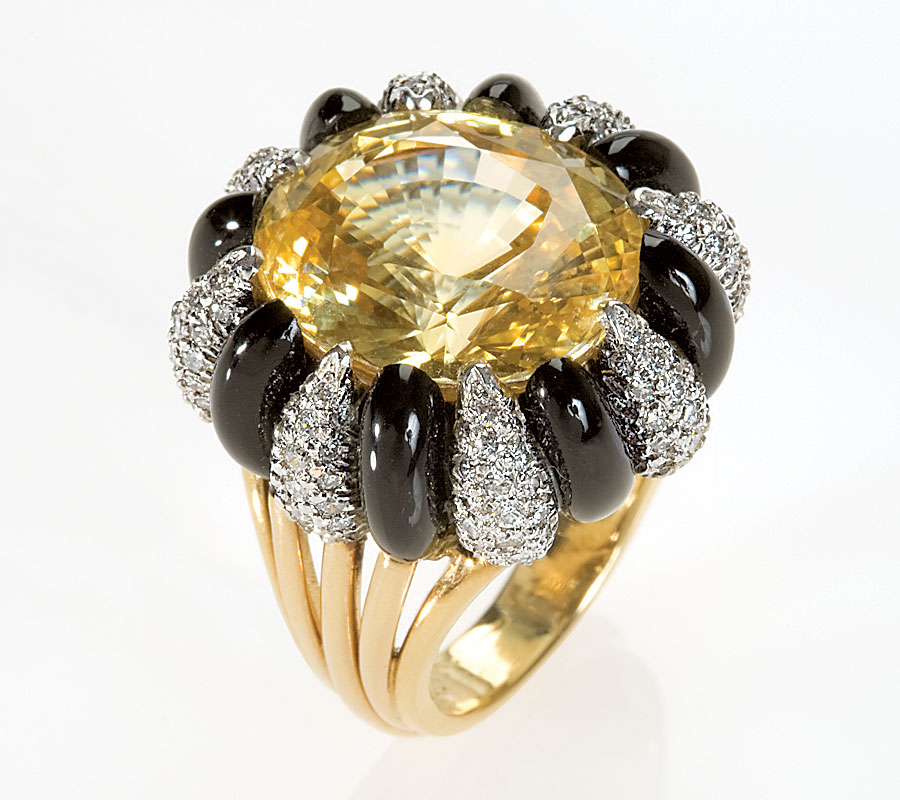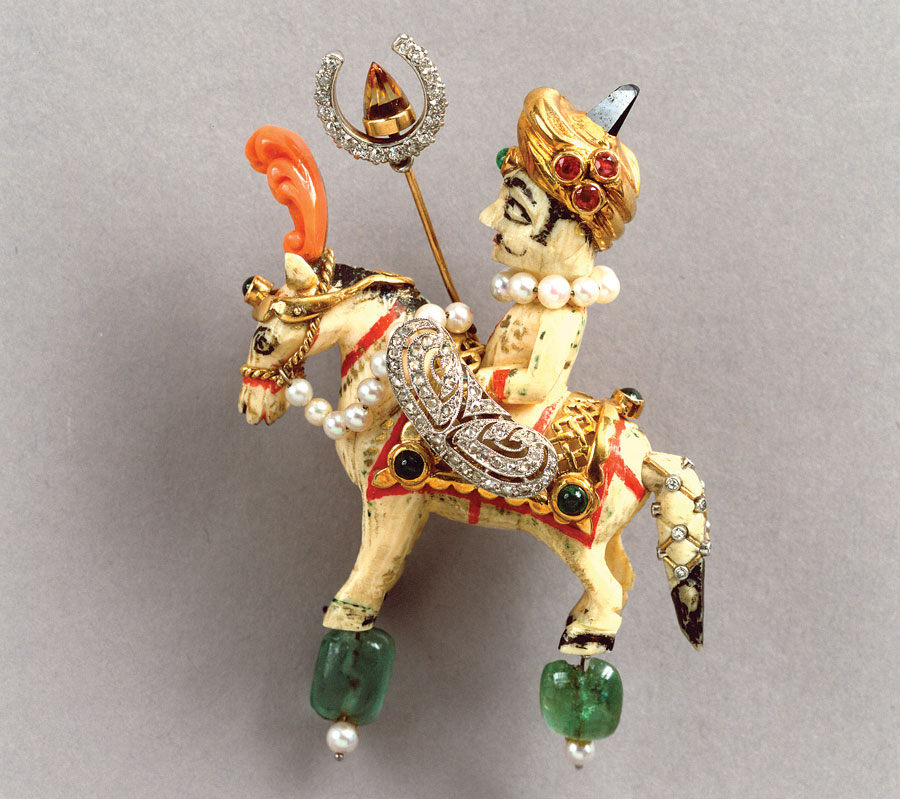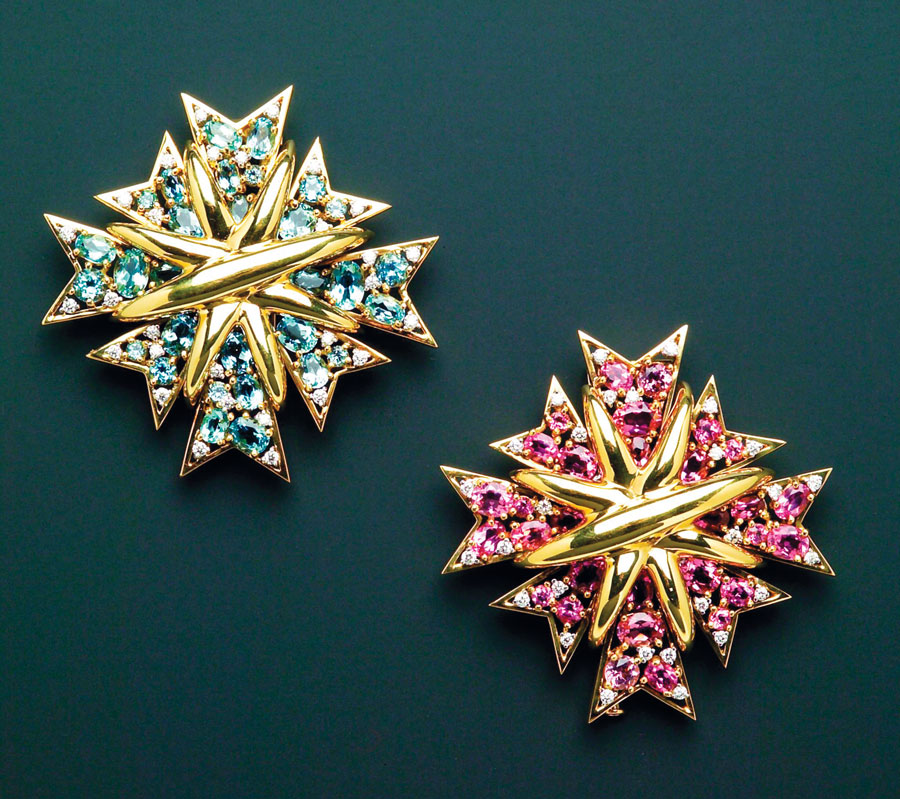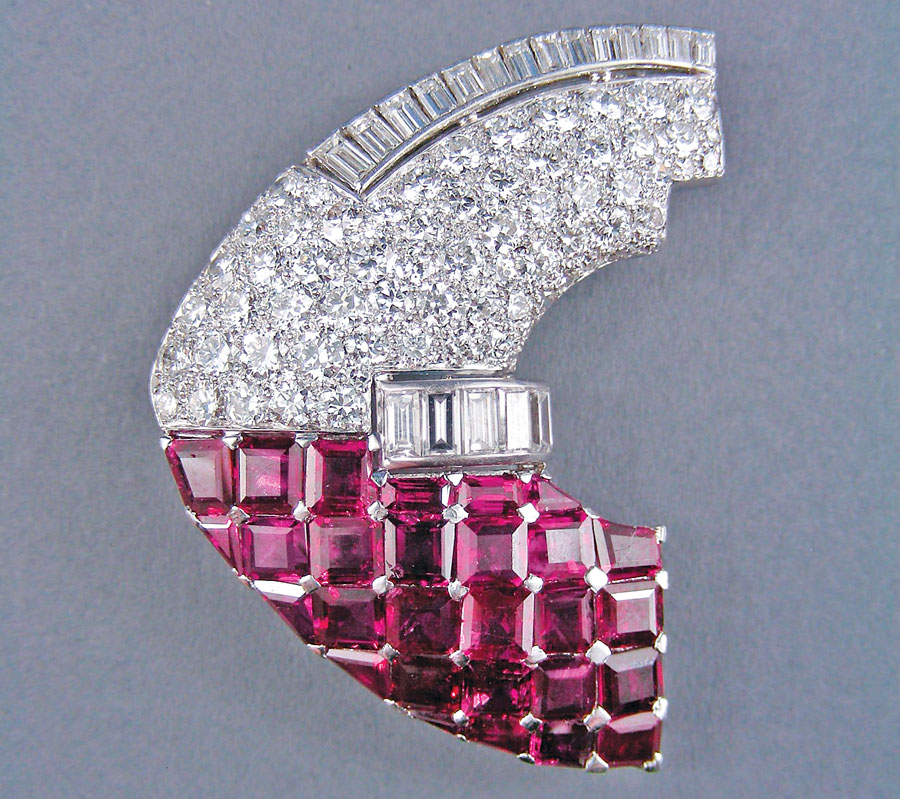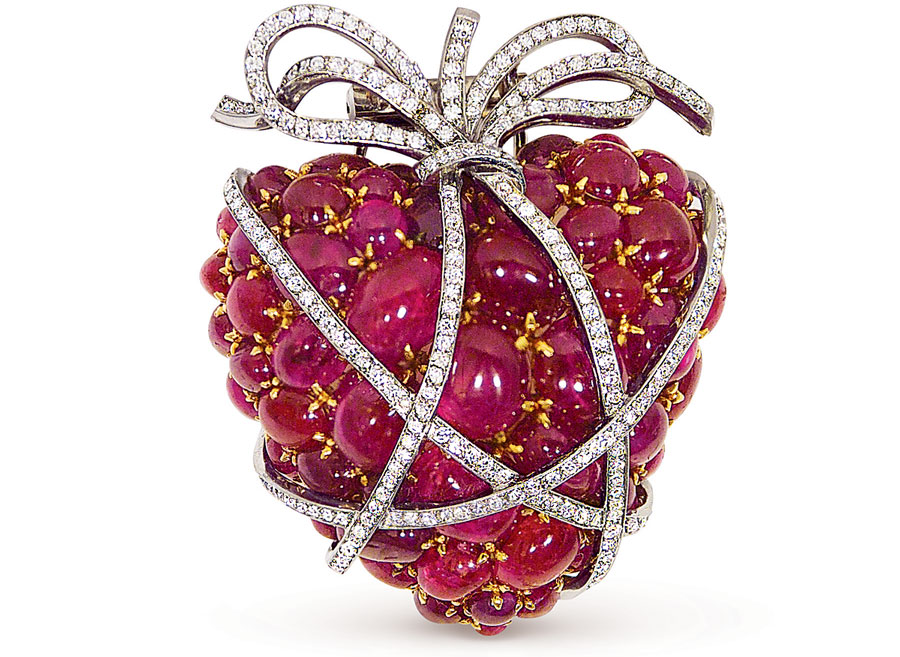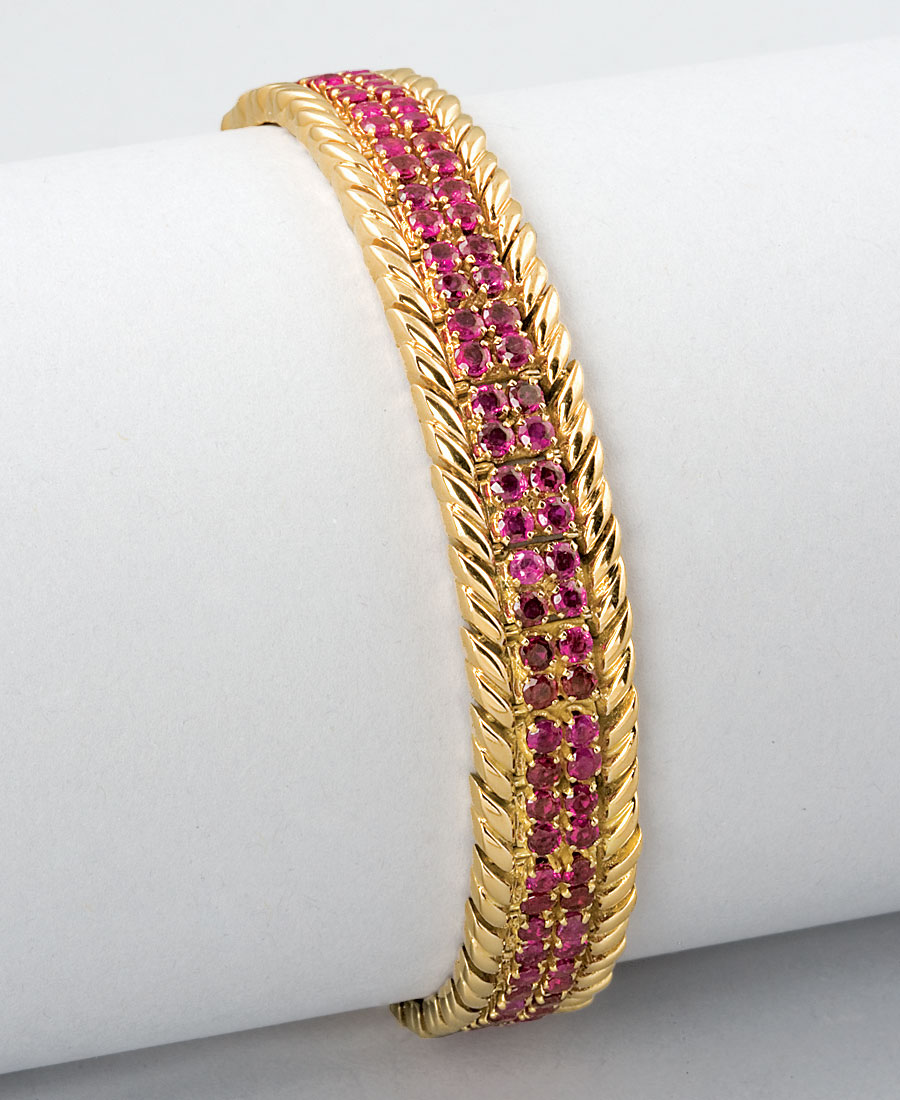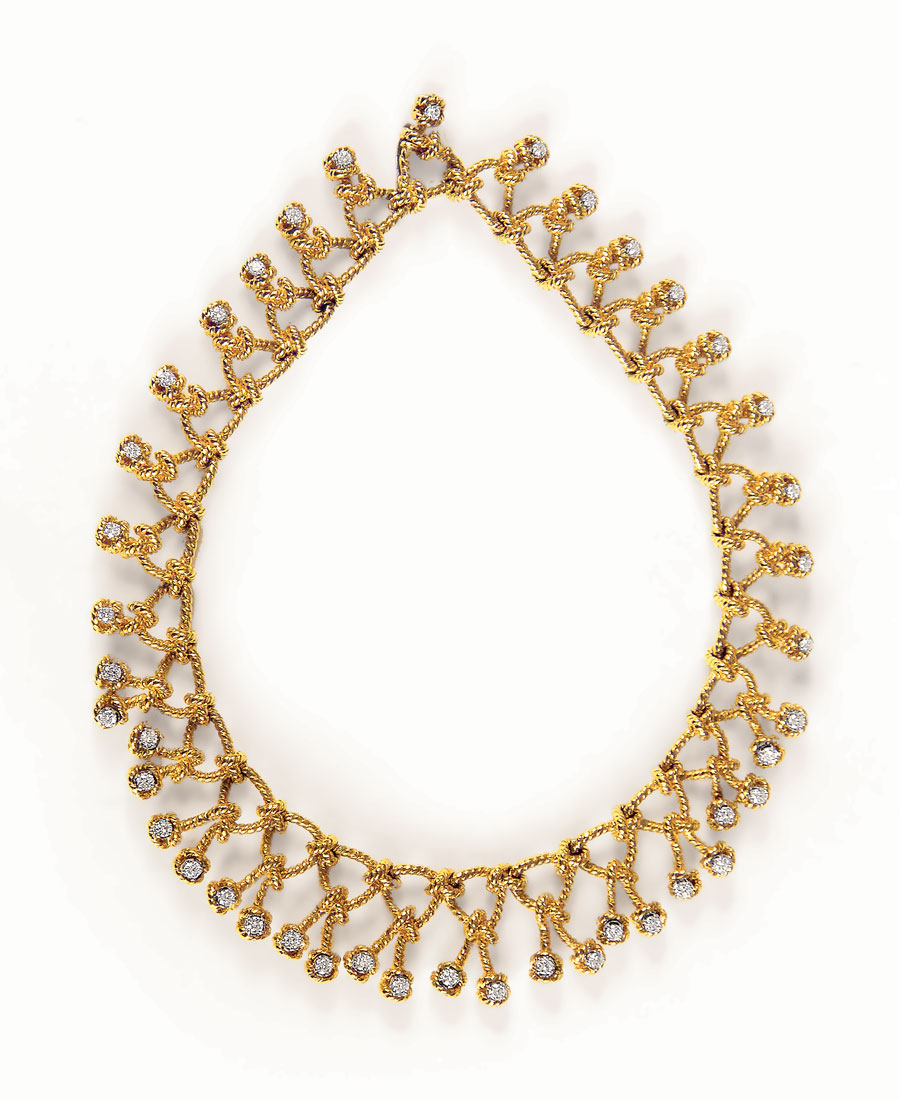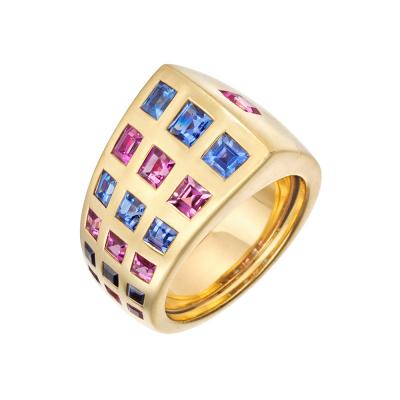Verdura Jewelry: Retro Glamour
He became one of the most important jewelry designers of the twentieth century, almost by accident. An aristocrat, a playboy, and ultimately, an artist, Verdura challenged and expanded the prevailing notions of his time about jewelry and fashion (Fig.1).1 In so doing, he created some of the most beloved and passionately collected jewelry available today. “Verdura jewelry,” says Ward Landrigan, CEO of Verdura, “is classic and iconic with an enduring style. Due to its timeless elegance, women lucky enough to inherit Verdura will never have to worry that they look as though they are wearing their grandmother’s jewels.”
Fulco Santostefano della Cerda, the Duke of Verdura was born in 1898, in Palermo Sicily. A sun-drenched paradise of citrus groves and mellow Marsala wines, Sicily was a popular destination, rivaling Paris for its glittering possibilities. The region is still known today as the conca d’oro (the golden conch); an image of the sea would reverberate throughout the life and work of the figure who Audrey Friedman of Primavera Gallery in New York, describes as “one of the most original and creative jewelry designers of the twentieth century.”
Fulco was raised in the aristocratic languor depicted in his cousin Prince Giuseppe di Lampedusa’s acclaimed novel, The Leopard, surrounded by art and antiquities. From its inlaid marble floors, heraldic shields, and baroque sea shells, his family palazzo was a playground for a nascent artistic imagination. The Verduras even maintained a private zoo. These familiar images from his childhood would surface again and again in Verdura’s jewelry designs as his artistic, emotional, and symbolic touch stones.
Although his upbringing was in many ways idyllic, Fulco found it stultifying and longed for a less insular world. After fighting in World War I and being wounded in Slovenia, Fulco moved to Paris to pursue a career as a painter. It was an intriguing moment in European history ripe with possibilities. The crumbling of the old social order had created a new class of social gypsies, the beginnings of what would later be called the “jet set.” Flamboyant, peripatetic, and restless in their search for beauty and pleasure, a new aristocracy of rich businessmen, artists, disenfranchised White Russians, and expatriates of every nationality met and mingled. Fulco Verdura was at the center of this motley, yet glamorous, crew.
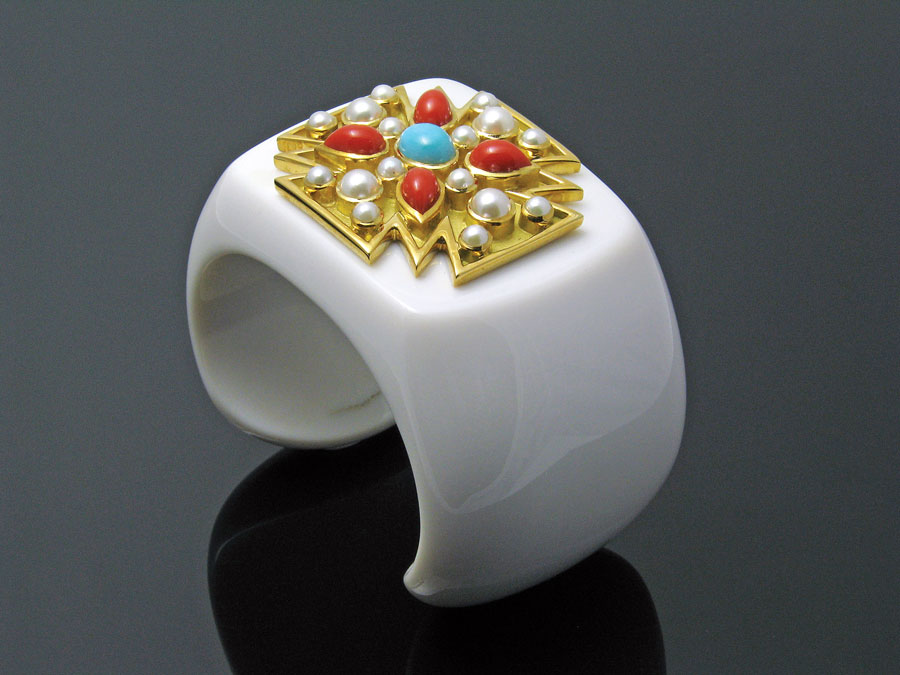
- Fig. 2: Verdura Maltese Cross cacholong cuff, ca. 1980. Pearl, coral, and turquoise set in 18kt gold. Courtesy of Camilla Dietz Bergeron, Ltd., New York.
Cole and Linda Porter were among the elegant world wanderers. The great American jazz composer and his wealthy, older wife met Fulco in Sicily and quickly became close friends with the witty, brilliant, and stylishly unemployed young duke. Later, in Paris, they introduced him to one of their close friends, Gabrielle “Coco” Chanel. The meeting was historic. Fulco later recalled, “She was the first person who ever took me seriously.”
Chanel was the first couturier to become a tycoon. A visionary, a revolutionary, and an artist, she recognized a kindred spirit in the young man whose life and background was diametrically opposed to her own. “Coco Chanel took a fancy to him, first as a painter,” explains Gus Davis of Camille Dietz Bergeron Ltd., of New York. “She saw in him someone with a great sense of style and self-possession.” Though Chanel hired Fulco in 1927 as a textile designer, their mutual love of jewelry led them in a different direction.
|
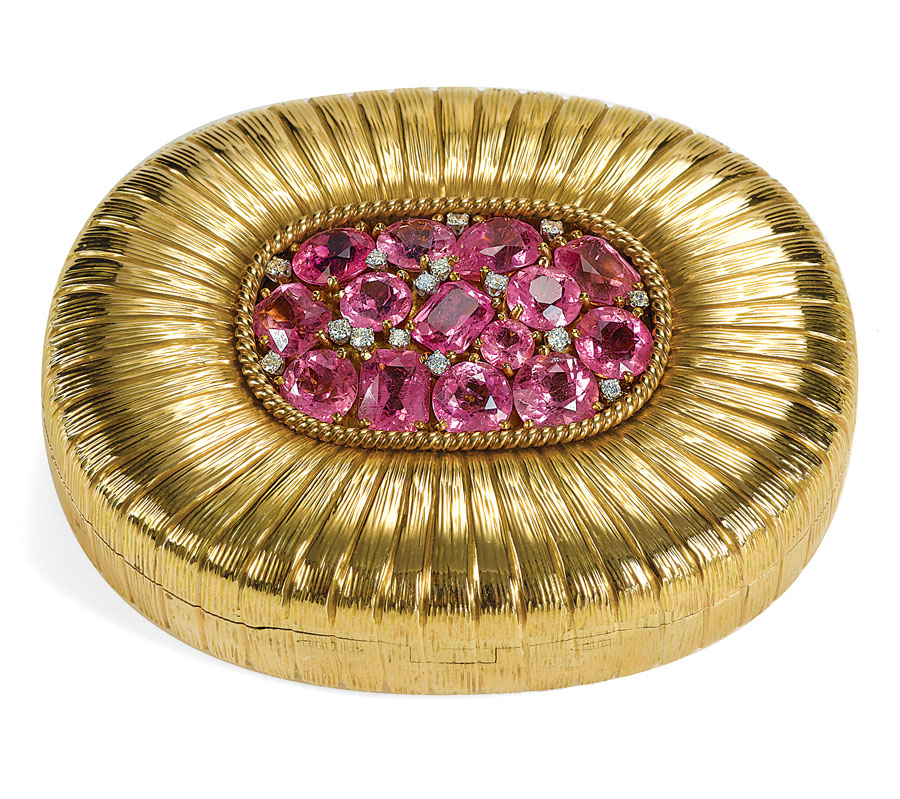
- Fig. 5: Verdura gold and pink gem stone compact, ca. 1950. 14kt gold; the top pavé-set with pink gem stones including pink topaz, morganite, pink sapphires, kunzite and diamonds. “Verdura was known to have used unusual materials and combinations. This box, for example, combined different types of pink stones with subtle differences in shade that added an element of three-dimensionality,” notes Rebecca Lai of A La Vieille Russie. Courtesy of A La Vieille Russie, New York.
Chanel and Verdura disliked the prevailing jewelry styles of the day: the airy delicacy of old Edwardian filigree and the stark, sharp angularity and frigid elegance of the new Art Deco. They admired color, and scale. Her taste had been influenced by her lover, Grand Duke Dmitri of Russia, who showered her with the pearls, weighty gold chains, and heavy, Byzantine cross pendants that had been part of his Imperial heritage. Working with Chanel, Verdura began designing the jewelry that came to define his aesthetic for the next fifty years.
He created “Byzantine” brooches of gold and colored stones, odd mixes of aquamarines, amethysts, and citrines, combined with rubies and sapphires without concern for which stones were “precious.” Sharing an indifference to the perceived “value” of stones, but intoxicated by their colors, Chanel and Verdura created jewelry inspired by royal or military medals and heraldic images. The “Maltese Cross” became their mutual trademark (Fig. 2).
The partnership eventually soured. Chanel taught Verdura a great deal, but she was a difficult woman, demanding, and megalomaniacal. Verdura wanted credit for his work, to be recognized for his art. He departed for America in 1934 with his friend, Baron Nicolas de Gunzburg.
America was a revelation for Verdura. He had never known such openness, such unprecedented social mobility. New York was a thrilling mélange of the moneyed, the talented, the beautiful, and brilliant, with artists, writers, and socialites mingling with a freedom and informality that was still unimaginable in Europe
Fulco and “Nicky” traveled to Hollywood and stayed at the Garden of Allah, the apartments-cum-artist colony once owned by silent screen siren Alla Nazimova. Fashion editor Diana Vreeland provided another fateful introduction, bringing Verdura together with Hollywood jeweler, Paul Flato. He bejeweled and accessorized some of the era’s biggest stars, including Fred Astaire and Cary Grant, who carried Paul Flato cigarette cases. Flato had a chic boutique on Sunset Boulevard, not far from the Garden of Allah. He hired Verdura.
|
|
“It became a working partnership,” explains Elizabeth Irvine, a specialist in the jewelry department at Christie’s in Los Angeles who is currently at work on a book about Paul Flato. “Flato was an ‘idea guy’: he didn’t draw, design, or fabricate jewelry. He was mostly a businessman. Verdura was the creative partner; Flato gave him the opportunity to create. Flato helped shape Verdura! And it’s now an iconic name in the history of jewelry!” Unlike Chanel, Flato was willing to share credit. Many pieces of this period are signed, “Verdura for Flato.”
Verdura left Flato in 1935. With help from Cole and Linda Porter, he opened his own business in 1938: a jewelry salon at 712 Fifth Avenue in New York City. The Porters were responsible for Verdura’s first important solo commission. The eccentric couple had a ritual in which Linda would present Cole with a custom-designed cigarette case in honor of each new Broadway show. For the opening of “Red Hot and Blue,” Verdura designed a platinum case pavéd with facetted rubies and sapphires and inlaid with gold stars at its sides and bottom. At its center was a starburst of round and baguette diamonds that could be detached and worn as a brooch. The cigarette case became the most highly publicized and much discussed bijou in New York.
Despite the Depression, there was a huge audience for the new kind of jewelry Verdura designed. The old royalty of Europe was in eclipse, and movie stars had become the new nobility. The biggest stars of all — Greta Garbo, Marlene Dietrich and Joan Crawford — all wore Verdura. They wanted jewelry that was bold and modern, photographed well, and was wearable and witty; Verdura’s designs were perfect. “He was part of a group of people who created a new sense of chic in the twentieth century,” says Simon Teakle of Betteridge Jewelers in Connecticut.
Working on his own, Verdura’s aesthetic blossomed. Says Gus Davis, “Verdura, in his era, was America’s first fashion jeweler…He took great pleasure in designing things that were amusing and beautiful.”
An intellectual as well as an aesthete, Verdura used the impressions of his Sicilian youth in his designs (Fig. 3). The ocean was a powerful metaphor for Verdura, and his aquatic imagery recalled his love of the sea, representing the unknown and unknowable, the subconscious and the submerged (Fig. 4). “He was [also] intrigued by religious imagery and supernatural images,” says Elizabeth Irvine. “Angels, astrology, and mythological creatures.”
Verdura worked mostly in gold, first as a personal preference, later, because platinum was being diverted to the war effort. His painterly obsession with color grew; white diamonds were relegated to a minor, supporting role in his jewelry, while amethysts, aquamarines, citrines, sapphires, and rubies took centre stage (Fig. 5).
He was strongly influenced by the artistic movements of the early twentieth century. Pablo Picasso was a close friend, and Fulco was fascinated by Surrealism. His friendship with Salvador and Gala Dali led to collaboration in 1945: a collection of cigarette cases and jeweled objects that Verdura called his “Freudian jewels.”
In 1947, Christian Dior’s “New Look” electrified the fashion world. It was perfect for Verdura’s bold designs and his brooches adorned many of the chicest lapels of the post-war years. The elegant, minimalist designs of Mainbocher and the resurgent house of Chanel were also ideal backdrops for Verdura’s jewels.
The 1950’s were the golden age of Verdura. Widespread prosperity and commercial air travel expanded the market for fine jewelry. In 1953 Verdura opened a Paris salon. Smaller and more private than his Fifth Avenue boutique, it catered to a discreet European clientele.
The Duke of Windsor, living in elegant exile in Paris became a customer, as did his beloved wife, Wallis. The Duchess of Windsor was a frequent but difficult customer, a demanding perfectionist. There was friction between her and the jeweler when she tried to pass off Verdura’s designs as her own. Still, he created important pieces for her, including the heart-shaped gold vanity case, topped with an aquamarine cabochon that sold for $146,667 at the Sotheby’s auction of the Duchess of Windsor’s jewels in 1987.
Opera star Maria Callas became a Verdura client, and fashion icon Babe Paley purchased dozens of pieces from him, including a 21.25 carat canary diamond ring. Verdura even met Elvis Presley and became a fan of the rocker, to the confused amusement of many of his friends.
Verdura’s three-dimensional heart-shaped brooches of colored stones, festooned in a ribbon of pavé diamonds became one of his most beloved and recognizable styles (Fig 6). Leaping dolphins set with glittering gems and graceful swans with baroque pearl bodies and single leaves, studded with citrines or yellow sapphires were popular designs. Another enduring Verdura motif was the chess piece: Fulco purchased a collection of antique ivory Mughal chessmen, and individualized each one by adding jeweled turbans, fans, swords or shields, and set them as brooches (Fig. 7). They became one of Verdura’s most popular designs: the demand for them was such that the firm made a policy of buying them back whenever they came up at auction. Verdura could always sell them again.
Fulco, the Duke of Verdura died in 1978. The company continued, but languished and the name lost some of its luster, eclipsed by houses like Van Cleef & Arpels, Cartier and Harry Winston. In 1985, the firm and its archives were purchased by Ward Landrigan. His relationship and fascination with Verdura spans a lifetime. “It was in 1965 when I first saw a Verdura piece,” he reminisces. “I was appraising a jewelry collection in Dallas for Lily Pons, a retired opera and movie star. In fact, it was her husband, Andre Kostelanaz, the conductor, who gave her the jewels. She showed me the Verdura “Pleiades” brooch, named after the seven sisters constellation. My first reaction was, ‘wow!’ I had never seen anything like it. Mrs. Pons was surprised that I had never heard about him, and suggested that I do some homework on my return to New York.”
Ward Landrigan embraces his role, not just as the company head but as Verdura’s historian and archivist. “When I was lucky enough to purchase his business,” he says, “I felt a responsibility to keep his legacy as one of the greatest jewelers of the twentieth century alive.” Of Landrigan, Simon Teakle says, “He has done an amazing job, preserving the heritage of Verdura.”
|
In the late 1980s, two significant auctions, the Duchess of Windsor’s jewelry sale and the Andy Warhol estate, brought renewed attention to jewelry designed in the 1940s and 1950s, including Verdura. “Twenty-five years ago, Verdura was a secret; only for the cognoscenti,” says Gus Davis. “Now, any time I get a piece of Verdura’s jewelry in stock, it creates a great deal of excitement. People swoon over it.”
Though there is demand for vintage Verdura, the supply is finite. Verdura was a prolific designer, but as Ward Landrigan observes, “Very little comes on the market, as most families prefer to keep the customized Verdura pieces.” He maintains a private collection of his own, which he calls his “Museum Collection”; those pieces will never be offered for sale.
Nevertheless, Verdura is passionately collected by a new generation, and it fascinates young women like Elizabeth Irvine. “It’s high fashion; high style,” she says. “They are statement pieces. When you wear Verdura, you’re wearing a work of art.”
-----
Lynn Morgan is a freelance writer based in Los Angeles. She is the author of Modern to Classic: Residential Estates by Landry Design Group (2006).
This article was originally published in the 2009 Palm Beach Jewerly, Art & Antique Show guide.















